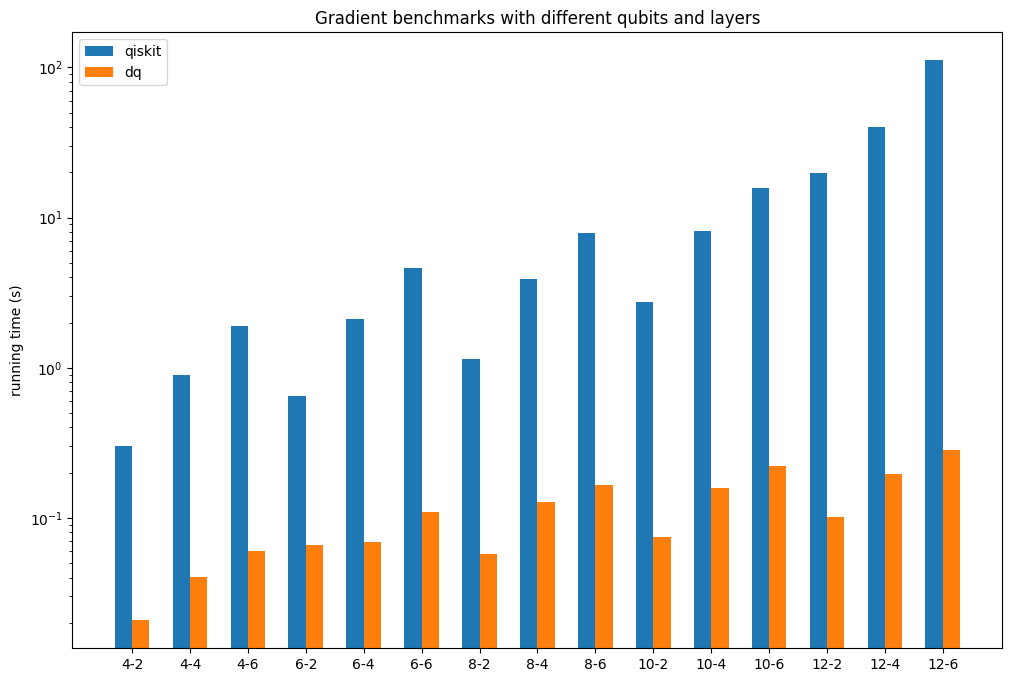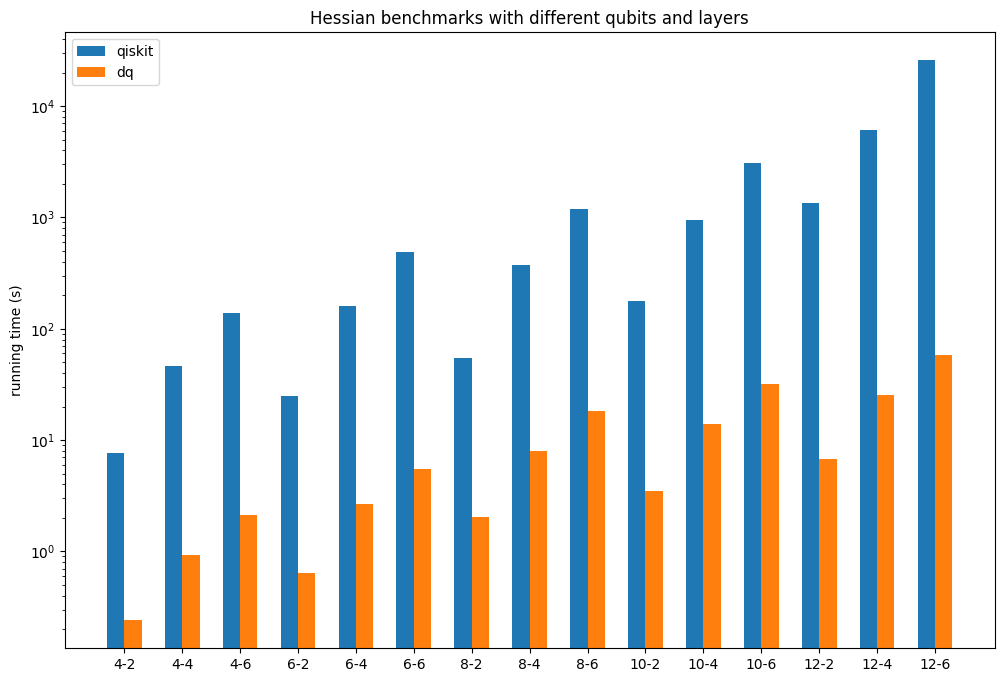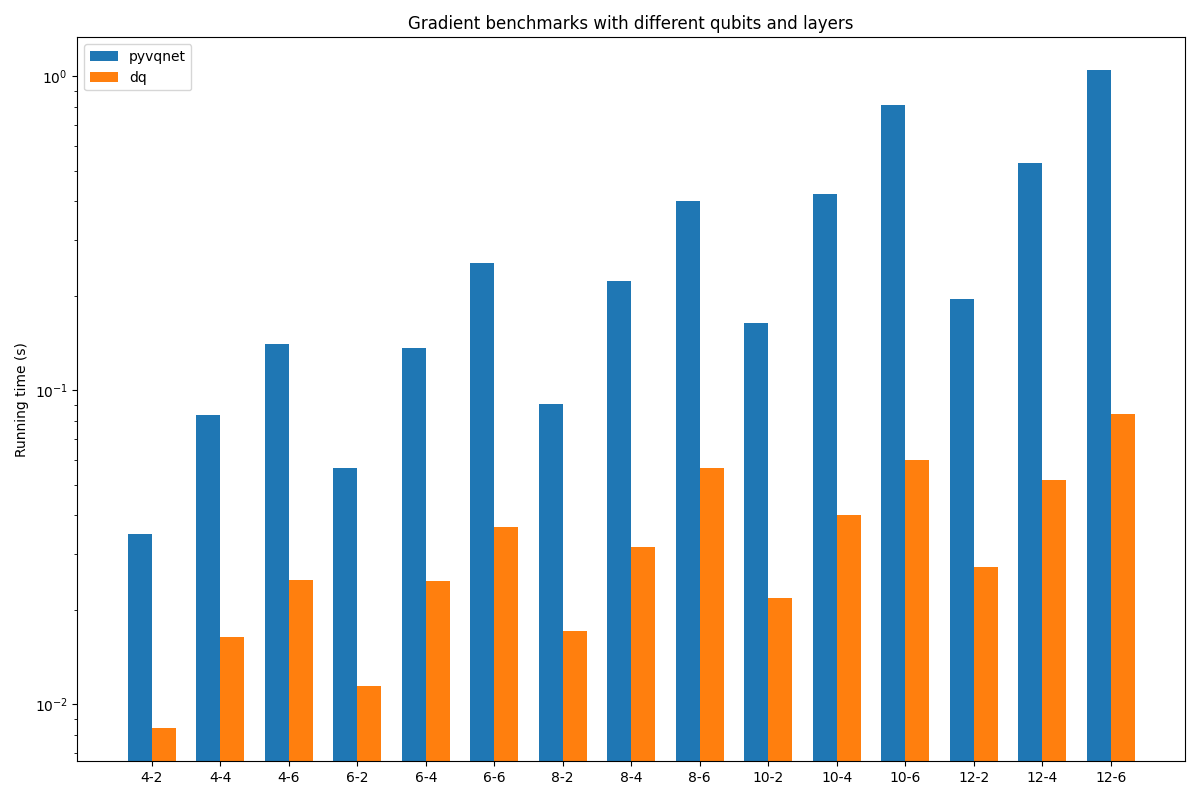案例#
混合量子-经典模型#
混合量子-经典模型,即结合了经典神经网络和量子神经网络,在图像处理、推荐系统、组合优化等领域已经有了各种研究和应用。 DeepQuantum与PyTorch的编程风格完全一致,因此基于DeepQuantum和PyTorch可以很方便、自然地实现混合量子-经典模型。
class Hybrid(nn.Module):
def __init__(self, dim_in, nqubit):
super().__init__()
self.fc1 = nn.Linear(dim_in, nqubit)
# 构建好的线路本身就是nn.Module
self.cir = self.circuit(nqubit)
self.fc2 = nn.Linear(nqubit, 1)
def circuit(self, nqubit):
cir = dq.QubitCircuit(nqubit)
cir.hlayer()
# 准备将经典数据编码到量子线路中
cir.rylayer(encode=True)
cir.rxlayer()
cir.cnot_ring()
for i in range(nqubit):
cir.observable(i)
return cir
def forward(self, x):
x = torch.arctan(self.fc1(x))
# 前向计算的第一个参数对应于要编码的数据
self.cir(x)
exp = self.cir.expectation()
out = self.fc2(exp)
return out
nqubit = 4
batch = 2
nfeat = 8
x = torch.sin(torch.tensor(list(range(batch * nfeat)))).reshape(batch, nfeat)
net = Hybrid(nfeat, nqubit)
y = net(x)
print(y)
for i in net.named_parameters():
print(i)
量子线路的灵活性#
DeepQuantum支持通过加法来对线路进行拼接,对于量子线路的使用非常灵活。
nqubit = 2
batch = 2
data1 = torch.sin(torch.tensor(list(range(batch * nqubit)))).reshape(batch, nqubit)
data2 = torch.cos(torch.tensor(list(range(batch * nqubit)))).reshape(batch, nqubit)
cir1 = dq.QubitCircuit(nqubit)
cir1.rxlayer(encode=True)
cir2 = dq.QubitCircuit(nqubit)
cir2.rylayer(encode=True)
cir3 = dq.QubitCircuit(nqubit)
cir3.rzlayer()
data = torch.cat([data1, data2], dim=-1)
cir = cir1 + cir3 + cir2 + cir3 # 线路相加后直接形成一个新的量子线路
cir.observable(0)
cir(data)
print(cir.expectation())
当然,上面的结果也可以由多个子线路的分段演化得到。
state = cir1(data1)
state = cir3(state=state)
state = cir2(data2, state=state)
state = cir3(state=state)
cir3.reset_observable()
cir3.observable(0)
print(cir3.expectation())
梯度计算的benchmark#
对于量子模拟器来说,运行效率是最重要的评价指标之一。对于VQE和量子机器学习等任务,除了量子线路的前向演化,梯度的计算是影响运行效率的最重要的因素。下面展示了DeepQuantum和Qiskit、VQNet的对比。
import time
import torch
from torch.autograd.functional import hessian
import deepquantum as dq
def benchmark(f, *args, trials=10):
time0 = time.time()
r = f(*args)
time1 = time.time()
for _ in range(trials):
r = f(*args)
time2 = time.time()
if trials > 0:
time21 = (time2 - time1) / trials
else:
time21 = 0
ts = (time1 - time0, time21)
print('staging time: %.6f s' % ts[0])
if trials > 0:
print('running time: %.6f s' % ts[1])
return r, ts
def grad_dq(n, l, trials=10):
def get_grad_dq(params):
if params.grad != None:
params.grad.zero_()
cir = dq.QubitCircuit(n)
for j in range(l):
for i in range(n - 1):
cir.cnot(i, i + 1)
cir.rxlayer(encode=True)
cir.rzlayer(encode=True)
cir.rxlayer(encode=True)
cir.observable(basis='x')
cir(data=params)
exp = cir.expectation()
exp.backward()
return params.grad
return benchmark(get_grad_dq, torch.ones([3 * n * l], requires_grad=True))
def hessian_dq(n, l, trials=10):
def f(params):
cir = dq.QubitCircuit(n)
for j in range(l):
for i in range(n - 1):
cir.cnot(i, i + 1)
cir.rxlayer(encode=True)
cir.rzlayer(encode=True)
cir.rxlayer(encode=True)
cir.observable(basis='x')
cir(data=params)
return cir.expectation()
def get_hs_dq(x):
return hessian(f, x)
return benchmark(get_hs_dq, torch.ones([3 * n * l]))
具体结果如下图所示:



大规模模拟#
用经典计算机对量子线路进行模拟,所需的计算资源会随着量子比特数的增加而呈指数级增长。DeepQuantum底层实现了张量网络算法,得以支持大规模的模拟。 用户只需要设置QubitCircuit的mps=True即可,并且可以用chi来调节基于张量网络近似量子态的精度,chi越大模拟精度越高,运行速度越慢。
batch = 2
nqubit = 100
data = torch.sin(torch.tensor(list(range(batch * nqubit)))).reshape(batch, nqubit)
cir = dq.QubitCircuit(nqubit, mps=True, chi=4)
cir.rylayer(encode=True)
cir.rxlayer()
cir.cnot_ring()
for i in range(nqubit):
cir.observable(i)
cir(data)
print(cir.expectation())
量子傅里叶变换#
量子傅里叶变换是离散傅里叶变换的量子对应。 DeepQuantum基于Ansatz类实现了量子傅里叶变换(Ansatz类只是在QubitCircuit的基础上对新增的输入参数进行了有效性的判断)。用户同样可以基于Ansatz类来方便地复现和开发各种量子算法。 下面是具体的实现。
class QuantumFourierTransform(dq.Ansatz):
# the default output order of phase is x/2, ..., x/2**n
# if reverse=True, the output order of phase is
# x/2**n, ..., x/2
def __init__(self, nqubit, minmax=None, reverse=False,
init_state='zeros', den_mat=False,
mps=False, chi=None, show_barrier=False):
super().__init__(nqubit=nqubit, wires=None, minmax=minmax,
ancilla=None, controls=None,
init_state=init_state,
name='QuantumFourierTransform',
den_mat=den_mat, mps=mps, chi=chi)
self.reverse = reverse
for i in self.wires:
self.qft_block(i)
if show_barrier:
self.barrier(self.wires)
if not reverse:
for i in range(len(self.wires) // 2):
self.swap([self.wires[i], self.wires[-1 - i]])
def qft_block(self, n):
self.h(n)
k = 2
for i in range(n, self.minmax[1]):
self.cp(i + 1, n, torch.pi / 2 ** (k - 1))
k += 1
量子相位估计#
量子相位估计算法是很多量子算法的关键。假设一个幺正算符U作用在其本征态 |u⟩ 上会出现一个相位 \(e^{2{\pi}i{\psi}}\) ,相位估计算法的作用就是对这个相位 \(\psi\) 进行估计。 下面演示的是DeepQuantum中已经实现的量子相位估计的例子,即针对单量子比特的相移门,得到它的相位。
t = 3 # 用来估计相位的qubit数量
phase = 1 / 8 # 待估计的相位
qpe = dq.QuantumPhaseEstimationSingleQubit(t, phase)
qpe()
res = qpe.measure(wires=list(range(t)))
max_key = max(res, key=res.get)
phase_est = int(max_key, 2) / 2 ** t
print(phase_est == phase)
Shor算法#
Shor算法是最知名的量子算法之一,其要解决的问题是:给定一个整数N,找出它的质因数。 下面我们用DeepQuantum来演示Shor算法,在分解整数15的最小案例中,使用了特定的受控Ua门来简化线路。
import math
from fractions import Fraction
mod = 15 # 待分解的数
a = 7 # 与待分解的`mod`互质
ncount = 8 # 用来估计相位的qubit数量
found = False
trial = 0
while not found:
trial += 1
print(f'\ntrial {trial}:')
cir = dq.ShorCircuitFor15(ncount, a)
cir()
res = cir.measure(wires=list(range(ncount)), shots=1)
max_key = max(res, key=res.get)
phase = int(max_key, 2) / 2 ** ncount
frac = Fraction(phase).limit_denominator(mod)
r = frac.denominator
print(f'Result: r = {r}')
if phase != 0:
guesses = [math.gcd(a ** (r // 2) - 1, mod), math.gcd(a ** (r // 2) + 1, mod)]
print(f'Guessed Factors: {guesses[0]} and {guesses[1]}')
for guess in guesses:
if guess not in [1, mod] and (mod % guess) == 0:
print(f'*** Non-trivial factor found: {guess} ***')
found = True
也可以使用更通用的线路来分解其他数,但会需要更多的计算资源和运行时间。
mod = 21
a = 2
ncount = 8
found = False
trial = 0
while not found:
trial += 1
print(f'\ntrial {trial}:')
cir = dq.ShorCircuit(mod, ncount, a)
cir()
res = cir.measure(wires=list(range(ncount)), shots=1)
max_key = max(res, key=res.get)
phase = int(max_key, 2) / 2 ** ncount
frac = Fraction(phase).limit_denominator(mod)
r = frac.denominator
print(f'Result: r = {r}')
if phase != 0:
guesses = [math.gcd(a ** (r // 2) - 1, mod), math.gcd(a ** (r // 2) + 1, mod)]
print(f'Guessed Factors: {guesses[0]} and {guesses[1]}')
for guess in guesses:
if guess not in [1, mod] and (mod % guess) == 0:
print(f'*** Non-trivial factor found: {guess} ***')
found = True